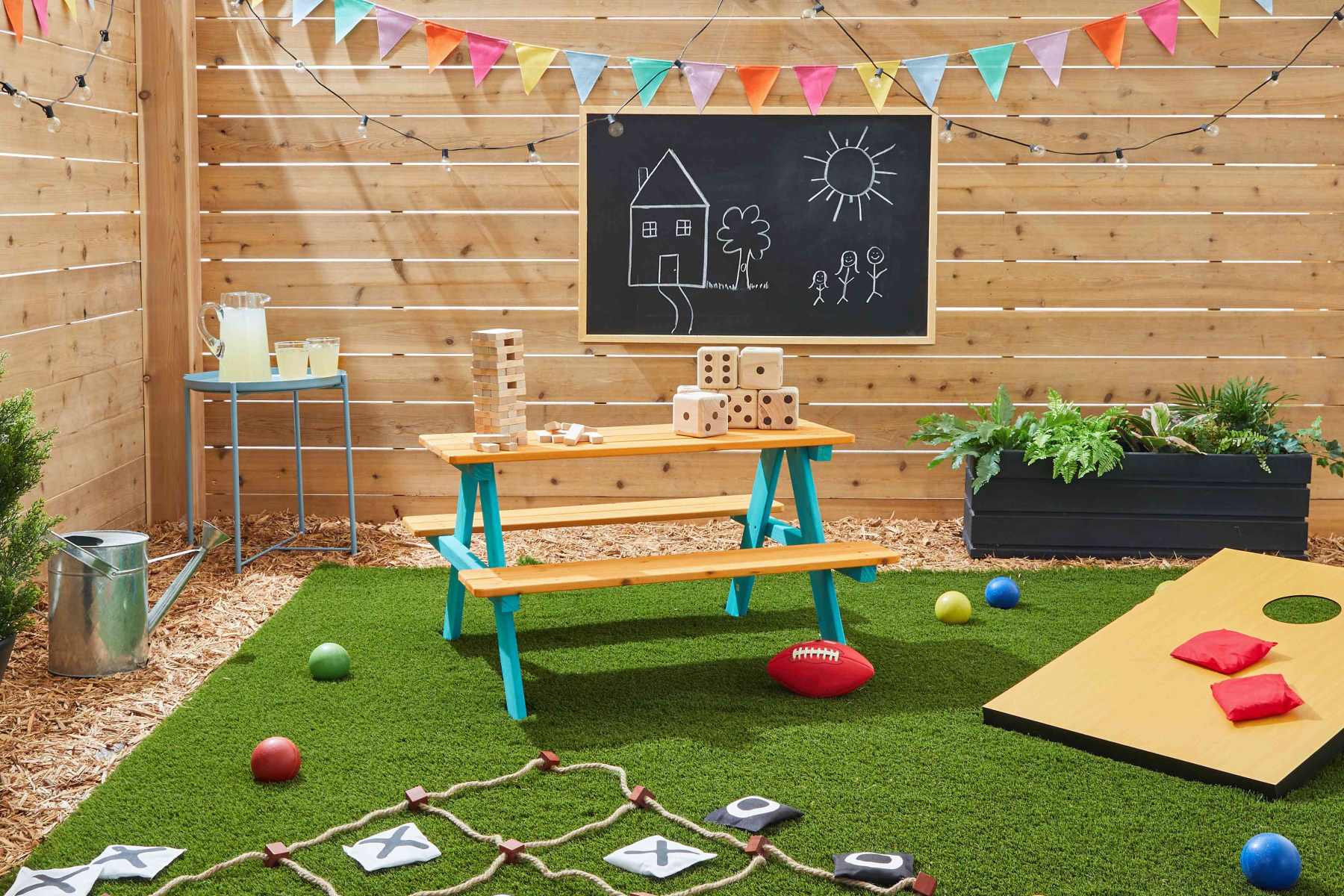Home>Health & Lifestyle>Family & Pet-Friendly Home Design>How Does Home Life Affect A Child’s Development


Family & Pet-Friendly Home Design
How Does Home Life Affect A Child’s Development
Published: December 22, 2023
Discover the impact of home life on a child's development with family and pet-friendly home design tips. Create a nurturing environment for your child to thrive.
(Many of the links in this article redirect to a specific reviewed product. Your purchase of these products through affiliate links helps to generate commission for Storables.com, at no extra cost. Learn more)
Introduction
Read more: How Technology Affects Home Life
The Crucial Connection Between Home Life and Child Development
The home is the cornerstone of a child's life, serving as the foundation for their physical, emotional, and cognitive development. The family environment, parenting styles, and overall home dynamics play a pivotal role in shaping a child's growth and well-being. Understanding the profound impact of home life on a child's development is essential for creating nurturing and supportive environments where children can thrive.
In this article, we will delve into the intricate interplay between home life and child development, exploring how family dynamics, parenting styles, home environment, and relationships within the family unit significantly influence a child's cognitive, emotional, and social development. By shedding light on these interconnected elements, we aim to provide valuable insights into the profound ways in which home life shapes the trajectory of a child's growth and development.
Join us on this enlightening journey as we uncover the multifaceted impact of home life on child development, gaining a deeper understanding of the pivotal role that families play in nurturing the next generation. Let's embark on this exploration to recognize the power of home environments in fostering the holistic development of children.
Key Takeaways:
- Family dynamics, parenting styles, and home environment profoundly shape a child’s emotional stability, communication skills, and social development, highlighting the pivotal role of nurturing family environments in fostering children’s holistic well-being.
- The interconnected elements of home life, including authoritative parenting, stimulating learning environments, and positive family relationships, serve as catalysts for children’s cognitive growth, emotional resilience, and social adeptness, laying the groundwork for the next generation to flourish.
The Impact of Family Dynamics on Child Development
Family dynamics encompass the intricate interplay of relationships, communication patterns, and interactions within the household. These dynamics exert a profound influence on a child’s development, shaping their social, emotional, and cognitive growth in fundamental ways.
Emotional Stability: A harmonious and supportive family environment provides a crucial foundation for a child’s emotional well-being. When children are raised in a nurturing and secure household, they are more likely to develop a strong sense of emotional security, resilience, and self-esteem. Conversely, exposure to conflict, instability, or neglect within the family unit can significantly impact a child’s emotional stability, potentially leading to anxiety, low self-esteem, and behavioral challenges.
Communication and Problem-Solving Skills: Family dynamics greatly influence a child’s communication patterns and problem-solving abilities. Open, respectful, and constructive communication within the family fosters the development of effective communication skills in children. Furthermore, observing healthy conflict resolution and problem-solving strategies within the family unit equips children with essential skills for navigating interpersonal relationships and addressing challenges in their own lives.
Identity Formation: The dynamics within the family unit play a pivotal role in shaping a child’s sense of identity and self-concept. Positive reinforcement, encouragement, and acceptance within the family contribute to a child’s healthy self-image and the development of a strong, positive identity. Conversely, negative dynamics, such as criticism or invalidation, can hinder a child’s self-discovery and self-acceptance, impacting their overall sense of identity.
Behavioral and Social Development: Family dynamics profoundly influence a child’s behavioral and social development. Children learn social norms, values, and behavioral patterns by observing and interacting within the family. Positive role modeling, encouragement of empathy, and opportunities for social engagement within the family unit contribute to the development of prosocial behaviors and healthy social skills in children.
By recognizing the far-reaching impact of family dynamics on a child’s development, we gain a deeper appreciation for the pivotal role that healthy, supportive family environments play in nurturing children’s holistic well-being. As we continue our exploration, we will delve into the influence of parenting styles on shaping child development, further illuminating the interconnected elements that contribute to the growth and flourishing of children within the home environment.
The Role of Parenting Styles in Shaping Child Development
Parenting styles serve as a cornerstone in shaping a child’s development, influencing their behavior, emotional well-being, and overall outlook on life. The manner in which parents interact with and nurture their children has a profound impact on various facets of their growth and development.
Authoritative Parenting: This style is characterized by warmth, responsiveness, and clear expectations. Authoritative parents maintain a nurturing and supportive environment while also setting reasonable boundaries and guidelines. Children raised by authoritative parents often exhibit high levels of self-esteem, self-discipline, and social competence. This parenting style fosters a healthy balance between autonomy and guidance, empowering children to develop essential life skills and a strong sense of self-efficacy.
Authoritarian Parenting: In contrast, authoritarian parenting is characterized by high demands and low responsiveness. Authoritarian parents prioritize obedience and discipline, often employing strict rules and consequences. While this approach may instill obedience in children, it can also lead to lower self-esteem, a lack of initiative, and challenges in social interactions. Children raised under authoritarian parenting may struggle with decision-making and assertiveness due to the restrictive nature of this style.
Permissive Parenting: Permissive parenting is marked by warmth and low demands, where parents are highly responsive but have few expectations or rules. While permissive parents often foster close and affectionate relationships with their children, the lack of structure and consistent boundaries can lead to difficulties in self-regulation and impulse control. Children raised under permissive parenting may encounter challenges in understanding limits and respecting authority figures.
Uninvolved Parenting: This parenting style is characterized by low levels of both responsiveness and demands. Uninvolved parents may be emotionally detached and provide minimal guidance or support to their children. This neglectful approach can have detrimental effects on a child’s development, leading to feelings of abandonment, low self-worth, and challenges in forming healthy relationships.
Understanding the distinct characteristics and implications of various parenting styles is crucial for fostering an environment that nurtures a child’s holistic development. By embracing authoritative parenting principles, which blend warmth with clear expectations, parents can empower their children to thrive emotionally, socially, and academically. As we delve deeper into the influence of the home environment on cognitive and emotional development, we will uncover the profound ways in which parenting styles shape the trajectory of a child’s growth and well-being.
The Influence of Home Environment on Cognitive and Emotional Development
The home environment plays a pivotal role in shaping a child’s cognitive abilities and emotional well-being, providing a nurturing backdrop for their intellectual growth and emotional resilience. From the early formative years through adolescence, the home serves as a rich and influential context for fostering cognitive development and emotional intelligence.
Stimulating Learning Environment: A home environment that prioritizes intellectual stimulation and exploration can significantly enhance a child’s cognitive development. Exposure to age-appropriate books, educational toys, and engaging activities fosters curiosity, creativity, and a love for learning. Furthermore, parents who actively engage in conversations, storytelling, and educational games with their children create an enriching environment that supports language development, critical thinking, and problem-solving skills.
Emotional Nurturing: Emotional development thrives in a home environment characterized by warmth, empathy, and open communication. When children feel emotionally supported and validated within their family, they are better equipped to understand and regulate their emotions. Parents who model empathy, express affection, and provide a safe space for emotional expression contribute to their children’s emotional intelligence and resilience, nurturing their capacity for empathy, self-awareness, and healthy coping strategies.
Routines and Consistency: Establishing consistent routines within the home environment fosters a sense of security and predictability for children, which is essential for both cognitive and emotional development. Predictable daily routines, such as regular mealtimes, bedtime rituals, and designated study periods, provide a stable framework that supports children’s cognitive organization and emotional well-being. Consistency in expectations and routines fosters a sense of stability and security, allowing children to focus on learning and emotional growth without the distraction of uncertainty or unpredictability.
Positive Reinforcement and Encouragement: A home environment that celebrates effort, perseverance, and achievements contributes to a child’s cognitive and emotional development. Encouraging a growth mindset, where children are praised for their resilience and willingness to tackle challenges, fosters a sense of confidence and a positive attitude toward learning. Additionally, providing constructive feedback and acknowledging a child’s emotional experiences with empathy and validation nurtures their emotional intelligence and self-esteem.
By recognizing the profound influence of the home environment on cognitive and emotional development, we gain valuable insights into the ways in which parents and caregivers can create nurturing and supportive contexts that optimize children’s growth and well-being. As we continue our exploration, we will delve into the effect of family relationships on a child’s social development, further illuminating the interconnected elements that shape the trajectory of a child’s holistic development within the home environment.
Tip: Create a stable and nurturing home environment for your child by providing love, support, and consistent routines. Encourage open communication and positive interactions to promote healthy development.
Read more: How Home Life Affects Education
The Effect of Family Relationships on Social Development
Family relationships serve as a fundamental influence on a child’s social development, shaping their ability to form and maintain relationships, navigate social interactions, and develop empathy and cooperation. The dynamics within the family unit profoundly impact a child’s social skills, emotional intelligence, and overall capacity for healthy interpersonal connections.
Role Modeling: Within the family environment, children observe and internalize social behaviors, communication patterns, and conflict resolution strategies. Positive role modeling of respectful communication, empathy, and cooperation within the family unit lays a strong foundation for children to emulate these behaviors in their interactions with peers and authority figures. Conversely, negative or unhealthy dynamics within the family can impede a child’s ability to form positive social connections and navigate interpersonal challenges.
Emotional Regulation and Empathy: The quality of family relationships significantly influences a child’s emotional regulation and capacity for empathy. When children experience empathy, validation, and support within the family, they are more likely to develop a keen understanding of others’ emotions and perspectives. Conversely, exposure to conflict, hostility, or emotional neglect within the family can hinder a child’s ability to empathize and regulate their own emotions, impacting their social interactions and relationships with peers.
Communication Skills: The communication patterns and dynamics within the family environment play a crucial role in shaping a child’s communication skills and ability to express themselves effectively. Open, respectful, and constructive communication within the family unit nurtures children’s ability to articulate their thoughts, feelings, and needs, laying the groundwork for confident and effective communication in social settings. In contrast, exposure to hostile communication or a lack of open dialogue within the family can impede a child’s communication skills and hinder their social interactions.
Conflict Resolution: The manner in which conflicts are addressed and resolved within the family greatly influences a child’s approach to conflict in their social interactions. Families that model healthy conflict resolution strategies, such as active listening, compromise, and respectful negotiation, equip children with essential skills for resolving conflicts and navigating disagreements with peers. Conversely, exposure to hostile or unresolved conflicts within the family can lead to challenges in managing conflicts and maintaining healthy relationships outside the home.
By recognizing the profound impact of family relationships on a child’s social development, we gain valuable insights into the ways in which the family environment shapes a child’s capacity for empathy, communication, and healthy social interactions. As we reflect on the interconnected elements that contribute to a child’s holistic development within the home environment, we gain a deeper appreciation for the pivotal role that family dynamics play in nurturing the next generation’s social competence and emotional well-being.
Conclusion
Home life stands as a powerful crucible for the holistic development of children, intricately shaping their cognitive, emotional, and social growth. The impact of family dynamics, parenting styles, home environment, and relationships within the family unit reverberates throughout a child’s formative years, leaving an indelible imprint on their development and well-being.
By recognizing the profound influence of family dynamics, we acknowledge the pivotal role of a nurturing and supportive family environment in fostering a child’s emotional stability, communication skills, and social competence. The interplay of authoritative parenting, stimulating home environments, and positive family relationships serves as a catalyst for children’s cognitive growth, emotional resilience, and social adeptness.
As we traverse the landscape of home life and child development, we uncover the intricate tapestry of influences that shape the trajectory of a child’s growth. From the nurturing embrace of a stimulating learning environment to the profound impact of family relationships on social development, each element intertwines to create a rich and fertile ground for children to flourish.
Empowering parents, caregivers, and families with the knowledge of these interconnected influences is paramount in fostering environments where children can thrive emotionally, intellectually, and socially. By embracing the principles of nurturing family dynamics, supportive parenting styles, and enriching home environments, we lay the groundwork for the next generation to blossom into resilient, empathetic, and socially adept individuals.
As we conclude our exploration of the profound connection between home life and child development, we are reminded of the transformative power that families hold in shaping the future. With a deep understanding of the multifaceted influences at play, we embark on a collective journey to cultivate nurturing and enriching home environments that propel children toward a future brimming with promise and potential.
Let us continue to champion the vital role of home life in nurturing the holistic development of children, recognizing the profound impact that families wield in sculpting the next generation’s path toward emotional well-being, cognitive prowess, and social grace.
Frequently Asked Questions about How Does Home Life Affect A Child's Development
Was this page helpful?
At Storables.com, we guarantee accurate and reliable information. Our content, validated by Expert Board Contributors, is crafted following stringent Editorial Policies. We're committed to providing you with well-researched, expert-backed insights for all your informational needs.















0 thoughts on “How Does Home Life Affect A Child’s Development”